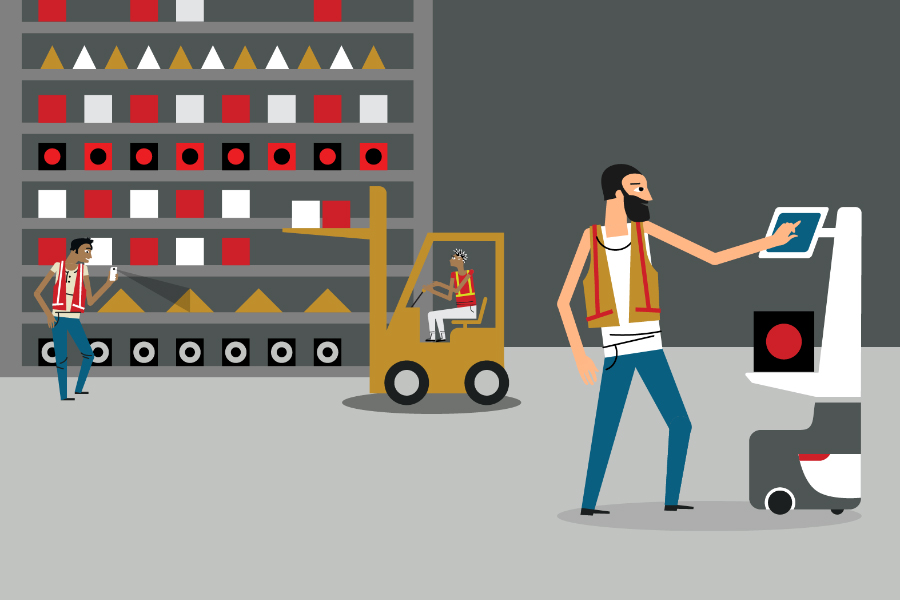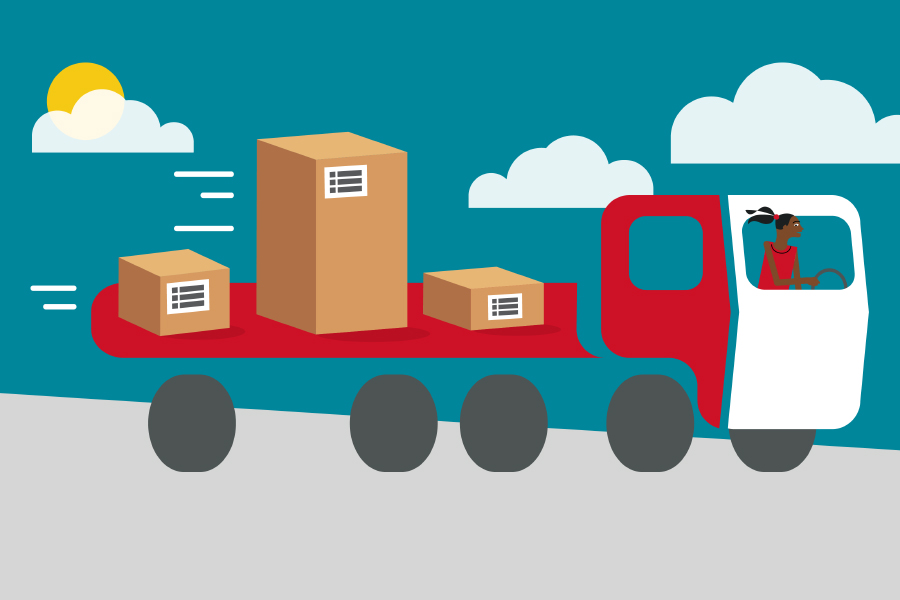[Updated post from January 14th, 2021]
For growing brands, periodically evaluating your current 3PL provider is a necessary part of doing business.
Why? Because as your business scales, your warehouse management needs are likely to evolve. This means the provider you initially partnered with may not be well-positioned to support your business as it grows and maximize efficiency.
But making the decision to switch to a new warehouse location - and a new fulfillment provider - is just the beginning. To ensure that this transition goes smoothly and doesn't result in any lost productivity, you need to follow best practices for moving to a new warehouse - no matter whether you have one warehouse or several.
In this post, we'll cover the four areas that your business should focus on when getting ready for your next warehouse move – and what your new partner should be doing to make this process as seamless as possible.
Why should I look at moving to a new facility?
There are a variety of reasons why your current 3PL may no longer be ticking the boxes for your business. Here are a few signs to look out for which might indicate that it's time to make the switch:
My 3PL can't scale with me
For businesses with rapidly growing order volumes, it's imperative to partner with a fulfillment provider who is agile and ready to scale alongside you. If you're experiencing a bump in orders due to a flash sale or a new product release, you don't want a cumbersome 3PL operation jeopardizing your ability to take advantage of growth opportunities.
If you're seeing signs that your 3PL is struggling to fulfill orders in a timely manner or stay on top of aged or dead inventory, it's a good sign that it's time to transfer to a new space that's better equipped for fast-moving inventory.
My 3PL isn't seeking to streamline their operations
A good fulfillment provider will be dedicated to continuous improvement and looking for ways to make its warehouses and distribution centers run more effectively.
Why? Because 3PLs need to be at the cutting edge of industry developments to meet rising consumer expectations. Rapid shipping, proactive order notifications, and memorable brand experiences are fast becoming the table stakes in e-commerce and retail.
If your fulfillment provider isn't looking at ways it can upgrade its facilities or utilize new technologies for warehouse management, then it's unlikely they can keep delivering a service that's fit for the times. In the long term, this coulld make it difficult for your business to remain competitive in the marketplace.
My 3PL is experiencing major logistical issues
This is always a clear sign that the time has come to make a warehouse transition. If your fulfillment operation is facing repeated problems, such as late shipments or inaccurate SKU counts, this has a massive knock-on effect on the overall efficiency of your fulfillment operation, especially during peak periods. This could also be an indicator of bigger issues to come as your business grows.
At the bare minimum, your fulfillment provider should be upfront about any challenges they're facing. If not, it's definitely time to start planning your warehouse move.
The warehouse move checklist: 6 steps for a smooth transition to a new warehouse
So, you've made the decision to switch fulfillment providers. What next? You need to put together a warehouse transition plan for how you're going to organize a smooth transition to your new 3PL and warehouse facility. Here are our top tips to make your warehouse move as stress-free as possible:
Have a strategy to phase out your old warehouse
It's no secret that moving fulfillment providers can be an overwhelming process. It's a multi-step transition that isn't going to happen overnight (and nor should it). That's why you need to have a solid handover plan in place to coordinate the shift from your existing warehouse to your new facility.
A handover plan ensures that your business doesn't face any major logistical issues during its warehouse move and the physical transfer of products, such as delayed inventory receiving or slower picking and packing.
Naturally, both your new and current 3PL are going to play a significant role in ensuring that your warehouse transition goes smoothly. This is why it's important to never burn bridges with your previous partner.
While your current provider is duty-bound to assist with offboarding your account, they can decide how helpful they want to be during this process. Ensuring transparency and good communication will help make this potentially awkward situation much more straightforward.
Your warehouse transition plan should always contain the following:
- A defined ‘overlap' period when both your old and new warehouses are online.
- Key dates/timeframes for the handover of critical operations i.e. receiving inventory, relocating SKUs and equipment, etc.
- A plan for how new employees will be onboarded into your account.
- Management of inventory e.g. transportation to new facilities.
At Ryder E-commerce by Ryder, we have dedicated support teams who are specially trained to oversee the entire onboarding process and support new customers as their operation comes online in our facilities. This ensures that once the transition is complete, they'll be no delays in getting orders out the door.
Understand your new distribution center locations
When you're changing fulfillment providers, there's a high likelihood that your warehouse locations are going to be different from what they were previously. This could be part of your motivation for making the switch, as your fulfillment center location is a vital piece of the puzzle to achieve fast delivery and lower shipping costs.
However, a change in location requires a shift in your shipping strategy. Depending on where your customer base is located, you may not be able to offer the same shipping timeframes or promotional deals you've used in the past. There may be opportunities to use regional parcel carriers or to allocate orders to different facilities which are closer to your end customer.
With our extensive distribution network and close proximity to major gateways in the United States, including Long Beach, New Jersey, Savannah, and Seattle-Tacoma, Ryder E-commerce by Ryder is uniquely positioned to move high volumes of inbound goods directly to the closest warehouse location via a multi-node fulfillment approach, ensuring maximum efficiency for merchants.
Get to grips with your new warehouse layout
Depending on how your business's storage and fulfillment needs have changed, your new facility may have a different layout and dimensions from your old warehouse. Although your new 3PL partner will have already worked with you on detailed planning for your warehouse operation, being able to set foot in your facility in person may bring up some additional thoughts for how you can optimize this space.
For example, warehouse space is at a premium across the U.S., so conserving space is necessary to run as cost-efficient an operation as possible. There may be some options to optimize space, such as bringing in new equipment with a smaller footprint or narrowing aisles to fit in more storage shelves.
Consider how to move inventory to your new location
Moving inventory isn't as simple as piling it into a truck and sending it to your new facility. Some SKUs will have specific handling requirements or need special equipment to be moved properly and avoid damage.
You also need carefully plan which products are going to be transferred and when. Ways that you can organize SKUs for transportation to your new location include:
- Product category
- Handling required e.g. hazmat items, fragile items
- Turnover
- Days on hand
- Quantity
- Storage type e.g. racks, pallets, etc.
For example, if you're a fast-fashion apparel company with high inventory turnover, it may not make sense to transport excess inventory to a new facility, since this would cost more than the inventory is worth. Instead, you may decide to either liquidate or heavily discount those SKUs to shift them in preparation for your warehouse moves.
It's important to undertake a full inventory count before your warehouse move, so you can make sure that everything makes its way seamlessly from your existing warehouse. It's advisable to budget for a certain amount of shrinkage due to breakage or loss during a move.
Prepare for integration with a new warehouse management system
A warehouse move involves far more than physical infrastructure. In 2023, just about every 3PL has its own advanced software systems for order and inventory management, one of the biggest selling points of outsourcing fulfillment.
A major part of successfully switching warehouses is ensuring that your e-commerce platform is fully integrated with your 3PL's warehouse management system well in advance of the commencement date of the contract. This way, you're set and ready to go the moment that customer orders start coming into your new warehouse.
The Ryder E-commerce technology platform uses a real-time inventory management system that offers seamless integration with a range of e-commerce platforms including Shopify. This ensures that merchants always have access to the latest data on orders, returns, and SKU counts – no matter where their new warehouse is situated.
Keep your customers and stakeholders informed
This is last, but definitely not least. When you're making a major supply chain decision like moving warehouses, it's vital that you keep your key stakeholders in the loop: namely, your customers.
While you might have a solid transition plan in place to keep your business running, the unexpected can always happen. Anything from delayed inventory transfers, integration issues, or equipment failure can result in delays in shipping and fulfillment.
For this reason, it's important to have a contingency plan in place. It might be necessary to put a temporary 'black out' in place for a few days during the transition, where new orders will not be processed. If this happens, be transparent and use channels such as email, social media, and your website to communicate these delays and keep your customers in the loop.
Moreover, consider using your new warehouse as a positive outreach opportunity; use your marketing channels to talk up the improved customer experience with your new 3PL – being proactive always pays dividends!
Getting ready for a warehouse move can be a stressful experience for brands. Putting in the legwork to create a warehouse transition plan early on in the process ensures that both your current and new 3PLs are on the same page and ready to assist you with your move.
Ready to look at moving to a new 3PL? Check out our post on 21 questions to ask a potential 3PL provider.




